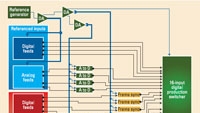The Opera and Ovation
Today's advanced camera systems can be set to operate in different pixel formats and at different frame rates. Accommodating these video formats in live production typically requires a complex system with many different components to make conversions. Making any change in the system creates challenges, including physical reconfiguration, which is time-consuming and tedious. Change also introduces the potential for error or failure. In addition, the requirement for additional components adds investment, maintenance and operational expense.
Simplifying production

Echolab's Opera SD and Ovation MD live production switchers accommodate different video formats, simplifying the production system. The switchers can work with different formats by incorporating many of the conversion, synchronizing and scaling functions that typically must be accomplished by peripheral hardware components. (See Figure 1.) The switchers feature new technology that uses high-speed shared memory blocks in conjunction with advances in the size and power of a field-programmable gate array (FPGA).
These new, large FPGAs have five times as many gates as those of the previous generation and six times the speed. Specifically, the underlying chip architecture incorporates two 32-bit PowerPCs running at 270MHz, embedded directly in the fabric of the FPGA and using Micrium's µ.C/OS-II, a real-time multitasking kernel. The hundreds of embedded high-speed multipliers within the FPGA fabric allow users to perform video effects such as wipes, mixes, DVEs and keys.
The design topology also grants the flexibility for these programmable effects and key layers without the need for additional internal components. This provides flexibility for efficient operation when source types or output destinations vary.
The use of large-scale FPGAs allows additional unique features to be added that were previously unavailable in traditional switcher designs. While digital storage for keys, fills and backgrounds are common within a modern switcher, the architecture of the Opera and Ovation systems provides the ability to associate independent storage of keys, fills or backgrounds to every input on the switcher. This provides the user with instant access to as many as 32 stores in addition to the central storage vault. As a result, a technical director can load these stores before an event and access them instantly without the need of preset recalls and reloads during live productions. This adds speed and efficiency to the task at hand.
Easy reprogramming
The professional video industry's #1 source for news, trends and product and tech information. Sign up below.
Echolab's FPGA technology offers another advantage as well. The architecture does not rely on fixed signal and data paths, so the platform can be reprogrammed as needs change or upgrades are needed.
While the inside of the switch has changed, control interfaces appear intuitive and familiar to the technical director. This is particularly crucial in a high-pressure video production environment. The need to reconfigure hardware to accommodate different formats adds time, complexity and staffing, not to mention undue stress, to the equation. A switch that can convert, synchronize and scale formatting means fewer hassles in production itself.
The Opera switcher handles both analog and digital inputs, internally crossconverts signals and synchronizes timing, and outputs composite and digital video. (See Figure 2.) This enables stations to eliminate external processing equipment from the production flow. Simplifying the process also enables broadcasters to focus on making production and video quality better by taking advantage of sophisticated features on the switcher.
Mix and match formats
With so many formats commonly in use, producers need increased flexibility in their system operations. Creating a multiformat production system, however, can be costly in terms of money, as well as time and complexity. The Opera SD and Ovation MD live production switchers allow users to mix and match formats, offering format independence. Additionally, their full feature sets help them reduce production costs and complexity.
